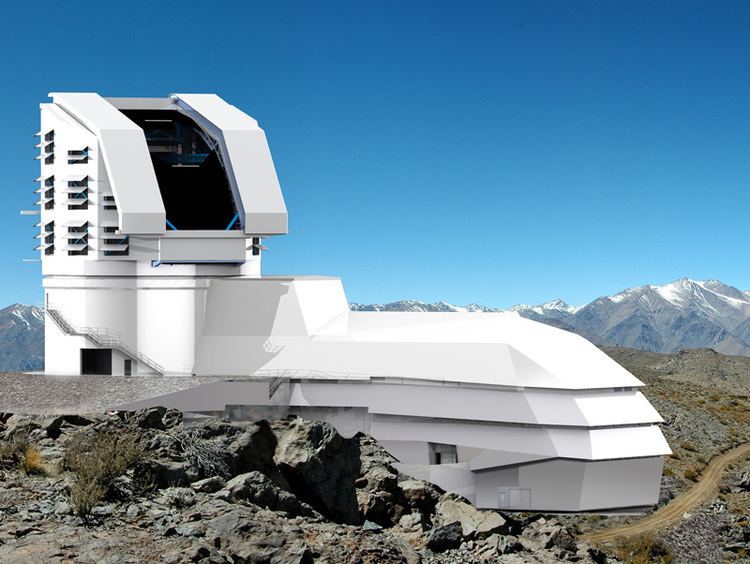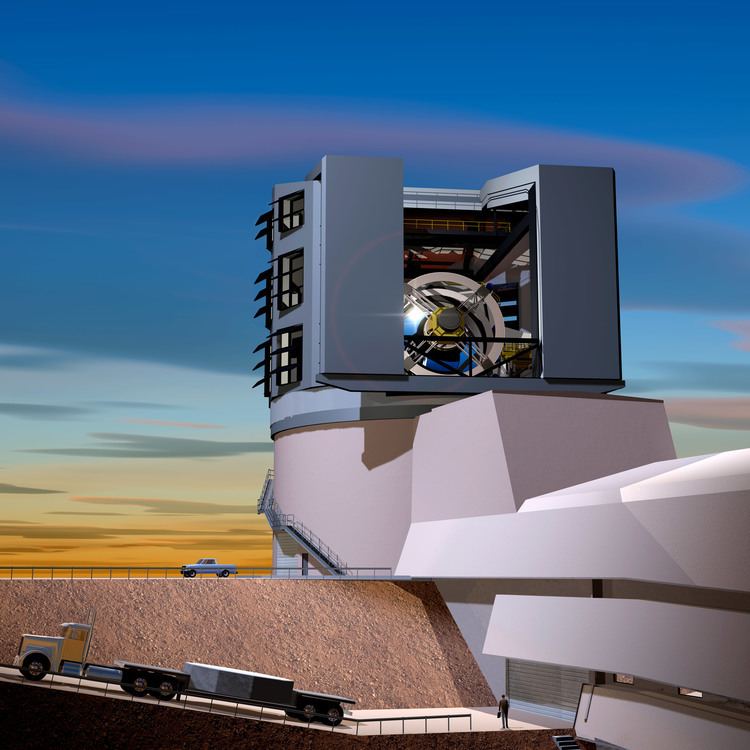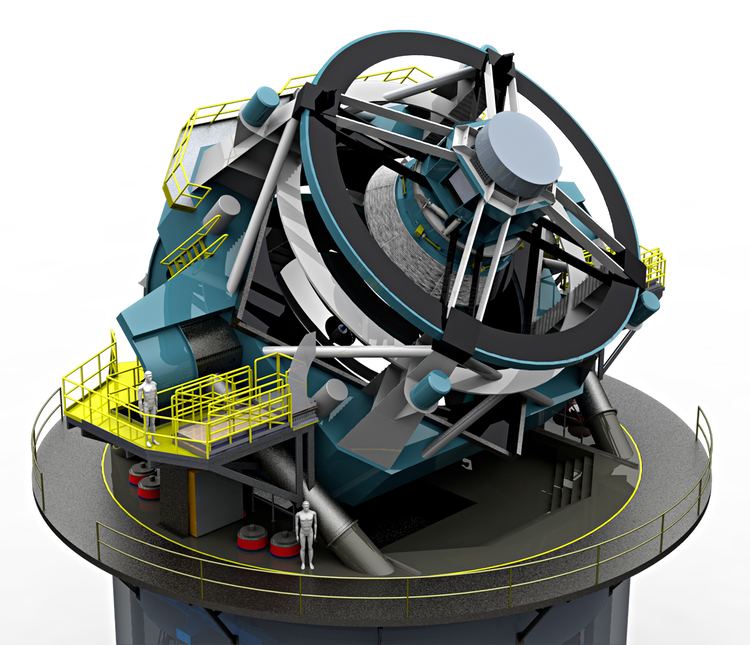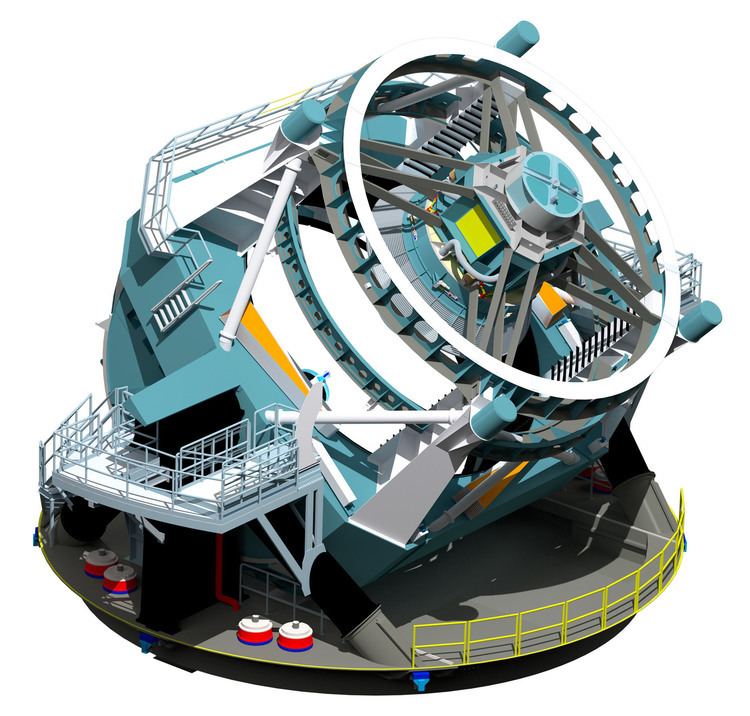Organisation LSST Corporation Wavelength 320–1060 nm First light 2019 | Location(s) El Peñón, Chile Built 2014–2019 (planned) | |
 | ||
Altitude 2,663 m (8,737 ft), top of pier | ||
The large synoptic survey telescope lsst camera
The Large Synoptic Survey Telescope (LSST) is a wide-field survey reflecting telescope with an 8.4-meter primary mirror, currently under construction, that will photograph the entire available sky every few nights. The telescope uses a novel 3-mirror design which delivers sharp images over a very wide 3.5-degree diameter field of view, feeding a 3.2-gigapixel CCD imaging camera, the largest digital camera ever constructed.
Contents
- The large synoptic survey telescope lsst camera
- Large synoptic survey telescope will bring a new view of the universe
- Overview
- Scientific goals
- Construction progress
- Optics
- Building
- Camera
- References

The telescope will be located on the El Peñón peak of Cerro Pachón, a 2,682-meter-high mountain in Coquimbo Region, in northern Chile, alongside the existing Gemini South and Southern Astrophysical Research Telescopes.

The LSST was the top-ranked large ground-based project in the 2010 Astrophysics Decadal Survey. The project officially began construction 1 August 2014 when the National Science Foundation (NSF) authorized the FY2014 portion ($27.5 million) of its construction budget. The ceremonial laying of the first stone was performed on 14 April 2015. Site construction began on April 14, 2015, with engineering first light anticipated in 2019, science first light in 2021, and full operations for a ten-year survey commencing in January 2022.

Large synoptic survey telescope will bring a new view of the universe
Overview

The LSST design is unique among large telescopes (8 m-class primary mirrors) in having a very wide field of view: 3.5 degrees in diameter, or 9.6 square degrees. For comparison, both the Sun and the Moon, as seen from Earth, are 0.5 degrees across, or 0.2 square degrees. Combined with its large aperture (and thus light-collecting ability), this will give it a spectacularly large etendue of 319 m2∙degree2.
To achieve this very wide, undistorted field of view requires three mirrors, rather than the two used by most existing large telescopes: the primary mirror (M1) is 8.4 metres (28 ft) in diameter, the secondary mirror (M2) is 3.4 metres (11.2 ft) in diameter (and will be the largest convex mirror ever made), and the tertiary mirror (M3), located in a large hole in the primary, is 5.0 metres (16 ft) in diameter. The large hole reduces the primary mirror's light collecting area to 35 square metres (376.7 sq ft), equivalent to a 6.68-metre-diameter (21.9 ft) circle. (Multiplying this by the field of view produces an etendue of 336 m2∙degree2; the actual figure is reduced by vignetting.)
The primary and tertiary mirrors (M1 and M3) are being constructed as a single piece of glass, the "M1M3 monolith".
A 3.2-gigapixel prime focus digital camera will take a 15-second exposure every 20 seconds. Repointing such a large telescope (including settling time) within 5 seconds requires an exceptionally short and stiff structure. This in turn implies a very small f-number, which requires very precise focusing of the camera.
The camera will include three corrector lenses to reduce aberrations; the first lens at 1.55m diameter will be the largest lens ever built. The filter will be between the second and third lens, with the third lens forming the vacuum window in front of the focal plane. The focal plane will be 64 cm in diameter, and will include 189 CCD detectors each of 16 megapixels.
Allowing for maintenance, bad weather and other contingencies, the camera is expected to take over 200,000 pictures (1.28 petabytes uncompressed) per year, far more than can be reviewed by humans. Managing and effectively data mining the enormous output of the telescope is expected to be the most technically difficult part of the project. Initial computer requirements are estimated at 100 teraflops of computing power and 15 petabytes of storage, rising as the project collects data.
Scientific goals
Particular scientific goals of the LSST include:
It is also hoped that the vast volume of data produced will lead to additional serendipitous discoveries.
Synoptic is derived from the Greek words σύν (syn "together") and ὄψις (opsis "view"), and describes observations that give a broad view of a subject at a particular time.
Some of the data from the LSST (up to 15 terabytes per night) will be made available by Google as an up-to-date interactive night-sky map.
Construction progress
LSST construction is underway, with the NSF funding authorized as of 1 August 2014.
Early development was funded by a number of small grants, with major contributions in January 2008 by software billionaires Charles Simonyi and Bill Gates of $20 and $10 million respectively. $7.5 million was included in the U.S. President's FY2013 NSF budget request. The Department of Energy is expected to fund construction of the digital camera component by the SLAC National Accelerator Laboratory, as part of its mission to understand dark energy.
The LSST was greatly encouraged by its selection as the highest-priority ground-based instrument in the 2010 Astronomy and Astrophysics Decadal Survey.
Optics
The primary mirror, the most critical and time-consuming part of a large telescope's construction, was made over a 7-year period by the University of Arizona's Steward Observatory Mirror Lab. Construction of the mold began in November 2007, mirror casting was begun in March 2008, and the mirror blank was declared "perfect" at the beginning of September 2008. In January 2011, both M1 and M3 figures had completed generation and fine grinding, and polishing had begun on M3.
The mirror was completed in December 2014. The M3 portion especially suffered from tiny air bubbles which, when they broke the surface, caused "crow's feet" defects in the surface. The bubbles trapped grinding abrasive, which produced scratches a few mm long radiating out from the bubble. Left as-is, these would enlarge the telescope's point spread function, reducing the sensitivity by 3% (to 97% of nominal) and increase the portion of the sky obscured by bright stars from 4% to 4.8% of the survey area. As of January 2015, the project was exploring ways to fill the holes and scratches and concluded no further polishing was necessary as the mirror surfaces exceeded the structure function requirements.
The mirror was formally accepted on 13 February 2015. It was then placed in the mirror transport box and stored in an airplane hangar until it is shipped to Chile.
The secondary mirror was manufactured by Corning of ultra low expansion glass and coarse-ground to within 40 μm of the desired shape. In November 2009, the blank was shipped to Harvard University for storage until funding to complete it was available. On October 21, 2014, the secondary mirror blank was delivered from Harvard to Exelis for fine grinding.
Building
Site excavation began in earnest March 8, 2011, and the site had been leveled by the end of 2011. Also during that time, the design continued to evolve, with significant improvements to the mirror support system, stray-light baffles, wind screen, and calibration screen.
In 2015, a large amount of broken rock and clay was found under the site of the support building adjacent to the telescope. This caused a 6-week construction delay while it was dug out and the space filled with concrete. This did not affect the telescope proper or its dome, whose much more important foundations were examined more thoroughly during site planning.
Camera
In August 2015, the LSST camera project, which is separately funded by the U.S. Department of Energy, passed its "critical decision 3" design review, with the review committee recommending DoE formally approve start of construction. On August 31, the approval was given, and construction is beginning at SLAC.
